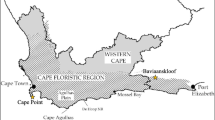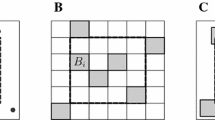Abstract
Count data arises in many contexts. Here our concern is with spatial count data which exhibit an excessive number of zeros. Using the class of zero-inflated count models provides a flexible way to address this problem. Available covariate information suggests formulation of such modeling within a regression framework. We employ zero-inflated Poisson regression models. Spatial association is introduced through suitable random effects yielding a hierarchical model. We propose fitting this model within a Bayesian framework considering issues of posterior propriety, informative prior specification and well-behaved simulation based model fitting. Finally, we illustrate the model fitting with a data set involving counts of isopod nest burrows for 1649 pixels over a portion of the Negev desert in Israel.
Similar content being viewed by others
References
Baker, M.B., Shachak, M., Brand, S., and Yair, A. (1998) Settling behavior of the desert isopod Hemilepistus reaumuri in response to variation in soil moisture and other environmental cues. Israel Journal of Zoology, 44, 345–54.
Besag, J. (1974) Spatial interaction and the analysis of lattice systems (with discussion). Journal of the Royal Statistical Society, Ser. B, 36, 192–236.
Besag, J., Green, P., Higdon, D., and Mengersen, K. (1995) Bayesian computation and stochastic systems (with discussion). Statistical Science, 10, 3–66.
Citron-Pousty, S. and Shachak, M. (1998) Comparative spatial patterns of the terrestrial isopod Hemilepistus reaumuri at multiple scales. Israel Journal of Zoology, 44, 355–68.
Clayton, D.G., and Bernardinelli, L. (1991) Bayesian methods for mapping disease risk in Small Area Studies, in Geographical and Environmental Epidemiology, J. Cuzick and P. Elliot (eds.), Oxford University Press, Oxford, pp. 205–20.
Cohen, A.C. (1991) Truncated and censored samples, Marcel Dekker, New York.
Cressie, N.A.C. (1993) Statistics for Spatial Data (rev. ed.), John Wiley, New York.
Dempster, A., Laird, N., and Rubin, D.B. (1977) Maximum likelihood from incomplete data via the EM algorithm (with discussion). Journal of the Royal Statistical Society, Ser. B, 39, 1–38.
Diaconis, P. and Ylvisaker, D. (1979) Conjugate priors for exponential families. Annals of Statistics, 7, 269–81.
Diggle, P.J., Tawn, J.A., and Moyeed, R.A. (1998) Model-based geostatistics (with discussion). Applied Statistics, 47, 299–350.
Gelfand, A.E. and Ghosh, M. (2000) Generalized Linear Models: A Bayesian Perspective, D.K. Dey, S.K. Ghosh and B.K. Mallick (eds.), Marcel Dekker, Inc., New York, pp. 3–14.
Gilks, W.R. and Wild, P. (1992) Adaptive rejection sampling for Gibbs sampling. Applied Statistics, 41, 337–48.
Ghosh, S.K., Mukhopadhyay, P., and Lu, J.C. (1998) Bayesian analysis of zero-inflated regression models. Technical Report, Department of Statistics, North Carolina State University.
Heilbron, D.C. (1994) Zero-altered and other regression models for count data with added zeroes. Biometrika, 36(5), 531–47.
Ibrahim, J.G. and Laud, P.W. (1991) On Bayesian analysis of generalized linear models using Jeffreys's prior. Journal of the American Statistical Association, 86, 981–6.
Johnson, N.L. and Kotz, S. (1969) Distributions in Statistics: Discrete Distributions, Houghton Mifflin, Boston, MA.
Kidron, G. (1998) Dew variability, lichen and cyanobacteria distribution along slopes at Sde Boqernorthern Negev. Jerusalem. Technical Report, New Mexico State University.
Lambert, D. (1992) Zero-inflated Poisson regression, with an application to defects in manufacturing. Technometrics, 34, 1–14.
Roberts, G.O. and Rosenthal, J.S. (1995) Optimal scaling of discrete approximations to Langevin diffusions. Research Report 95–11, Statistical Laboratory, Cambridge University.
Roberts, G.O. and Tweedie, R.L. (1996) Exponential convergence of Langevin diffusions and their discrete approximations. Bernouilli, 2, 341–64.
Shachak, M. and Brand, S. (1991) Relations among spatiotemporal heterogeneity, population abundance, and variability in a desert, in Ecological Heterogeneity, J. Kolasa and S.T.A. Pickett (eds.), Springer-Verlag, New York, pp. 202–23.
Shachak, M. and Yair, A. (1984) Population dynamics and role of Hemilepistus reaumuri (Audouin and Savigny) in a desert ecosystem. Symposium of Zoological Society of London, 53, 295–314.
Yair, A. and Shachak, M. (1982) A case study of energy, water and soil flow chains in an arid ecosystem. Oecologia, 54, 389–97.
Zagvil, A. (1996) Six years of dew observation in the Negev Desert, Israel. Journal of Arid Environments, 32, 361–71.
Author information
Authors and Affiliations
Rights and permissions
About this article
Cite this article
Agarwal, D.K., Gelfand, A.E. & Citron-Pousty, S. Zero-inflated models with application to spatial count data. Environmental and Ecological Statistics 9, 341–355 (2002). https://doi.org/10.1023/A:1020910605990
Issue Date:
DOI: https://doi.org/10.1023/A:1020910605990




